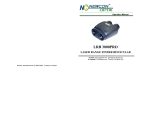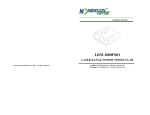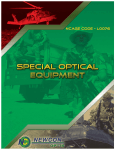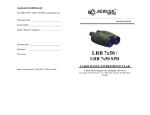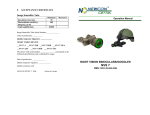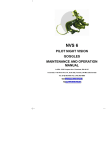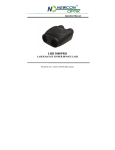Download Newcon Optik LRB 4000CI Binoculars User Manual
Transcript
10. QUALITY CERTIFICATE LRB 4000CI is suited for usage. Production date ____________________________ Serial number _____________________________ Operation Manual Device performance: Actual data Measured data Reflective object, m Non-reflective object, m Azimuth, ° Elevation, ° RS-232 interface Pass Quality Inspector signature___________________ Purchase date _____________________________ Salesman ________________________________ Quality Assurance Seal_____________________ LRB 4000CI LASER RANGE FINDER BINOCULAR Newcon International ltd. © 2005 Printed in Canada In USA: 3310 Prospect Ave. Cleveland, OH 44115 In Canada: 105 Sparks Ave., Toronto, ON M2H 2S5 IMPORTANT INFORMATION 9. CUSTOMER SUPPORT Read prior to activation Should you experience any difficulties with your Newcon OPTIK product, consult the enclosed manual. If the problem remains unresolved, contact our customer support department at (416) 663-6963 or Toll free at 1-877-398-6666. Our operating hours are 9am-5pm, Monday - Friday, Standard East Time. You have just purchased a complicated electronic device. To operate it properly, please read this manual carefully. Here are some common precautions that must be noted. • NEVER subject the unit to impact while operating or being transported • NEVER transport the unit without the case • NEVER disassemble the unit. This device contains high voltage components, which may be hazardous to you! • NEVER reverse the polarity of a battery • ALWAYS remove battery when not in use for a long period • ALWAYS store in a warm dry place when not in use • Caution - use of controls or adjustments, or performance of proceedings other than those specified herein may result in hazardous radiation exposure • Caution - the use of some optical instruments with this product will increase eye hazard 2 At no time should equipment be sent back to Newcon without following the instructions of our technical support department. Newcon accepts no responsibility for unauthorized returns. To locate NEWCON Authorized Dealer call: Tel: (416) 663-6963 Fax: (416) 663-9065 Email: NEWCONSALES@NEWCON-OPTIK.COM INTERNET: http://WWW.NEWCON-OPTIK.COM The defective products should be shipped to: In USA: 3310 Prospect Ave. Cleveland, OH 44115 In Canada: 105 Sparks Ave., Toronto, ON M2H 2S5 From International: 105 Sparks Ave., Toronto, ON M2H 2S5, CANADA 23 8. WARRANTY Features of the LRB 4000CI Laser Rangefinder Binocular NEWCON OPTIK warrants this product against defects in material and workmanship for one year from the date of the original date of consumer's purchase, but no more than 18 months from the date of manufacturing. If your Newcon product proves to be defective during this period, please bring the product securely packaged in its original container or an equivalent, along with proof of the date of original purchase, to your Newcon Dealer. Newcon will repair (or at its option replace), the product or part thereof, which, on inspection by Newcon, is found to be defective in materials or workmanship. What This Warranty Does Not Cover: NEWCON is not responsible for warranty service should the product fail to be properly maintained or fail to function properly as a result of misuse, abuse, improper installation, neglect, damage caused by disasters such as fire, flood, lightning, improper electrical current, or service other than by a NEWCON Authorized Service. Postage, insurance, or shipping costs incurred in presenting your NEWCON product for warranty service are your responsibility. Please include a check or money order made out to NEWCON OPTIK for the amount of $15.00 to cover shipping and handling. This covers products shipped in USA or Canada only. 22 • • • • • • • • • Latest digital circuitry allows targeting through most types of glass First, last or the most reflective target acquisition Meters/Yards/Mils/Degrees/KMH/MPH display Last 10 readings recall Selectable reticle shape (+ or □) Target quality indicator Gating capability Speed detector, compass, inclinometer RS-232 computer output 3 CONTENTS 1. Brief description 2. Appearance of the device 3. Supplied accessories 4. Technical characteristics 5. Operation instructions 5.1. Preparing the device for operation 5.2. Measuring procedure 5.3. Mode switching procedure 5.4. Gating distance selection 5.5. Additional display information 5.6. Computer interconnectivity 5.7. Test modes 6. Storage and maintenance instructions 7. Troubleshooting 8. Warranty 9. Customer Support 10. Quality certificate 4 7. TROUBLESHOOTING The range-measuring mode does not work. Press the Action button again. Check that the battery is installed properly. Check the charge of the battery. Replace it if it is weak. How can I clear last reading before making next measurement? Direct the unit’s LCD reticle at the new target, press the Action button. The new reading will appear. There are black dots in the image. A LCD (Liquid Crystal Display) is installed in the optical channel of the device. Due to manufacturing imperfections in the production process of the LCD, small black dots, scratches and other blemishes might be visible. Those blemishes are strictly regulated for maximum allowed number, size and location. It does not degrade the product's performance. Range measurement cannot be obtained. • Check if range detection mode is activated (message READY appears on the LCD display) • Check if Active Button is pressed • Make sure that neither your hand or finger is blocking objective lenses, Laser emitting lens or Receiver lens. • Check if the unit is steady while pressing Action button. • Check if gating mode is off 21 6. STORAGE AND MAINTENANCE INSTRUCTIONS. Precautions: LRB is a sophisticated precision optical instrument equipped with electronics. Therefore, it should be handled with due care. • Keep your device away from direct sunlight, impacts, dust, moisture, and sudden changes of temperatures. • Do not keep the device at temperatures higher than 65oC (149oF). • Do not touch the optical surfaces with fingers. Doing so may damage the anti-reflection coating. • Avoid shocks and sharp jolts. • Cleaning of optical surfaces is only allowed with professional camera lens cleaning supplies. • To clean the exterior of the device, use a soft clean cloth. • Keep away from heating appliances and central heating. • Remove the battery when storing the device for long period of time. • The manufacturer only can make repair works. CAREFULLY READ ALL THE INSTRUCTIONS BEFORE USING! FAILURE TO OBEY THE INSTRUCTIONS WILL VOID THE WARRANTY! 1. BRIEF DESCRIPTION LRB 4000CI Laser Rangefinder Binocular is the advanced Laser Range Finder system that provides instant distance, speed, and angular measuring consistently and accurately. The outstanding optics provides a sharp, clear image under all conditions. LRB utilizes a revolutionary digital design, which outperforms any other product in its class and price range. The unit sends an invisible, eye safe laser beam pulses to the target. The returned beams are captured by the digital circuitry. The time differential allows us to calculate the distance to the target. Built-in digital compass measures angle between the optical axis and direction to the North Pole. Built-in inclinometer allows elevation angle measuring together with height (depth) calculations. 20 5 2. APPEARANCE OF THE DEVICE 5.6. Computer interconnectivity The unit is equipped with standard RS-232 interface. The data is transmitted as ASCII code with fixed baud rate of 9600 bit/sec. 4 6 1 7 5 8 3 2 1 – Eyepieces; 2 – Objective lens – receiving lens; 3 – Objective lens emitting lens; 4 – Dioptric correction rings; 5 – Mode button; 6 – Action button; 7 – Body of the device; 8 – Rubber grip Fig. 1 6 5.7. Test modes Mode 16 is designated to test the display. When you choose this mode all segments and indicators will flash during 8 seconds. This time should be enough for extensive display testing. Mode 17 calibrates the digital compass. If the System was exposed to a strong magnetic field or it was inoperable for a long time the compass stops working. This is normal. To return the compass back into working condition, enter Mode 17 and rotate the unit several times around vertical axle, holding it horizontally. 45° 45° Repeat this operation, holding the unit at 45 360° 360° 360° degrees to the horizon up and down. The normal compass operation will be restored. 19 There are four statistical qualifications of the reflected signal: • NO TARGET REFLECTION – when a steady reflected signal isn’t received. Numerical display shows four dashes at the distance displaying area; • TARGET REFLECTION LOW – when the number of steady received reflected signals is just enough to make acceptable conclusion about the measured distance; • TARGET REFLECTION MED - when the number of steady received reflected signals is in medium range and enough to make positive conclusion about the measured distance; • TARGET REFLECTION HIGH - when the number of steady received reflected signals is qualified to be enough to make reliable conclusion about the measured distance. The displayed statistical qualification of the reflected signal characterizes variation in expected accuracy of measurements. At qualification HIGH the accuracy of measurements is stated as ±1m ± 0.1%. At lower rates of statistical qualification the expected accuracy may marginally degrade. The display presents message LOW BAT – when voltage of the primary 9-volt battery drops below 7.2 volt. At this point the System is still functional but the battery should be replaced as soon as possible. The System can operate at the voltage level above 7 volt. Alkaline or lithium type of batteries capable to sustain current drain up to 150 mA should be used for powering the System. 18 1 1 9 10 1 – Eyepiece; 9 – – Interpupilary distance adjustment lever; 10 – Battery compartment cover and identification label (located at the bottom) Fig. 2 3. SUPPLIED ACCESSORIES LRB is supplied in the following assembly: - Device - Carrying case - Neck strap - User’s manual - Warranty card - Computer cable - Floppy disk (optional) - 9V battery (optional) 1 pc. 1 pc. 1 pc. 1 pc. 1 pc. 1 pc. 1 pc. 1 pc. 7 4. TECHNICAL CHARACTERISTICS 1. Optics Magnification, x Objective Lens, mm Exit Pupil Diameter, mm Field of View Type of Coating Interpupilary distance, mm Diopter adjustment range Axial Resolution, ” Image tilt, maximum Horizontal Vertical 2. Range Finder Type Measuring Range, m Accuracy 'Last Target' measurement Meters/Yards display Last 10 readings recall Reticle shape Target quality indicator Gating capability, m 3. Speed Detection Measured speed range, kmh / mph Accuracy, kmH 4. Compass 5. Inclinometer 6. Misc. Measured azimuth range, mils/deg Accuracy, degrees Measured elevation range, degrees Accuracy, degrees Height measuring Battery (optional) 'Low Battery' Indicator Tripod thread Operational Temperature Range Storage Temperature Range Weight without battery, g Dimensions, mm 8 7 50 7.1 5° Fully multi-coated optics 58-72 ±4 6 60” 30” Class 1, eye safe, 905nm 20 – 4,000 ± 1m ± 0.1% Yes Yes Yes + or ٱ Yes 100 - 7,000; 100 m step 5 – 400 / 3-250 ±1 6400 / 360 ±1 ±60 ±0.4 Yes 9V Yes ¼” x 20 -25 / +50oC (-13 / +122oF) -45 / +65oC (-49 / +149oF) 1300 210 x 150 x 80 M/° - units of angular measurement: mils or degrees Shape of the reticle: cross shape or rectangular shape (2). rEC1 - recall function. Upon pressing the Action button (6) (fig. 1) the Display will sequentially show results of last 10 measurements, starting from the latest one. The number appearing after word "rEC" shows the number of the measurement counted back in the sequence. When the System is in inactive state the 10 previous measurements are stored within the System and may be recalled at any time. cLr - clear data function: upon pressing the Action button (6) (fig. 1) the entire data on all previous measurements will be erased. This function doesn’t change the chosen modes. You can erase the assigned mode only by assigning a new one. Note: After changing a battery the recall stack should be cleared by exercising the cLr mode. OVER 100 – indicates that gating mode is on. Distance measuring procedure includes instant statistical processing of the package of single measuring sessions for each laser pulse. Qualitative result of the statistical processing is presented on the Display as a message TARGET REFLECTION (5). 17 5.4. Gating distance selection You can exclude all targets, which are closer than the preset distance. This is useful when you aim your target through bushes or wires, or you are not interested in targets closer than a certain distance. The step of gating is 100 meters starting from 100 meters and up to 7000 meters (such a large maximum gating distance is reserved for future extensions). This means that you potentially can set the gating distance larger than the maximum measuring range. The device will not be able to measure anything in this regime. To remove gating mode you should choose Standard1 or Standard2 modes. Note: The gating distance can be increased only. If you want to decrease it, you should remove gating mode and then choose it again. Note: You can exit gating selection cycle without gating distance setting by clicking the M button 70 times (all possible gating distances passed, nothing was chosen) or by holding the M button during 2 seconds (“escape” function, see above). 5.5. Additional display information The System operates in the setting Modes that are displayed as follows (refer to Fig.3): Y/M – units of measurement: yards or meters (3). KMH/MPH – units of speed measurement: km/hour or miles/hour (3). 16 5. OPERATION INSTRUCTIONS 5.1. Preparing the device for operation. • Open battery compartment cover (10) (Fig. 2). • Insert one 9V battery (sold separately) into the battery compartment observing correct polarity. • Close the battery compartment cover (10), tighten the screw. After changing the battery, it is recommended to run the cLr (CLEAR) mode and Compass Calibration mode (refer mode selection procedure). Liquid Crystal Display (LCD) 7 6 1 8 5 9 2 4 3 1 – Low battery indicator; 2 – Reticle (cross or rectangular selectable); 3 – Units of measurement (Yards, Meters, KMH, MPH, Mils or Degrees); 4 – Measurement result; 5 – Target quality indicator; 6 – Laser active indicator 7 – Over 100m gating indicator, 8 – Setup mode indicator, 9 – Ready mode indicator Fig. 3 9 5.2. Measuring procedure When the Rangefinder is in the passive, zero power consumption state, the LCD Display is blank (transparent). Press the A button (6) (Fig.1) and hold for 0.5 sec. to activate the System and the Display. Initially the System always assumes READY mode of operation and word ‘READY’ appears on the Display. Pressing and releasing A button (6) (Fig. 1) at this point triggers a measuring session, and the result will be displayed in numerical form (4) (if measurement is unsuccessful then four dashes ‘----‘ will appear in the numerical area). Please note that the target must be over 20m away. The measured data will correspond to the mode selected (see below). The units of measurement will be indicated in the field (3) (Fig.3). If you choose more than one parameter to measure (for instance, distance and azimuth) the measured results will appear on the display every half second. The System remains in the active displaying state for 8 seconds after pressing of any of the 10 override reticle type and target selection with the sub selection code. For example, Standard 1 mode implies cross reticle. If you choose rectangular reticle (sub selection code 10), you change the reticle shape and leave all other parameters of this mode intact. If then you choose Standard1 again, the reticle will turn back crosshair. The last set mode overwrites all features that it controls. The third standard mode is assigned to Code 8. It determines measurement units and features as Yards, Degrees, Degrees, Crosshair reticle, Auto target selection. All other modes determine only one parameter to measure. For example, Code 14 allows to measure speed of the objects as kilometers per hour. The shape of reticle and target selection will remain the same, as they had been set before you selected the Code 14. Now you can choose a new reticle shape, still remaining in the speed measuring mode. This example demonstrates that Codes 9-13 replace one selected feature independently, and all other codes can replace more than one feature in a bunch. If you want to leave the mode switching procedure without remembering your choice, you should press and keep held the M button for more than two seconds. This works like “Escape” key on a computer keyboard. The rangefinder will remain in the last set mode and return to the READY state. Full trek of all possible modes available is depicted on Figure 4. 15 The mode selection logic allows choosing the nearest (‘first’), the farthest (‘last’) or the most reflective (‘auto’) target. Besides, you can exclude all targets that are closer than the predefined distance (gating distance selection, see below). 5.3. Mode switching procedure By pressing M button (5) (Fig.1) when the System is in READY mode, you enter the Mode selecting state. Pressing the M button sequentially scans the Modes. The Mode under selection is indicated on the Display by flashing of the selectable feature. The "flashing" feature can be selected by pressing the A button (6). If you don’t find some of the modes described below, it means they were not installed on your system. Two modes, “Codes” and “Recall” have submenus. You enter submenu by pressing the A button from the corresponding mode. After that you can select the sub-item with M button and choose your option by pressing the A button. Each time when you make your choice, you return to the READY state. Note: Depending on user’s requirements, the unit can be made with a special sub selection, providing only the options required for the particular task. Note: Depending on the software installed the situation when the mode is accessible but inoperable also may occur. There are two preset modes, Standard1 (Meters, Degrees, Degrees, Crosshair reticle, Auto target selection) and Standard2, which open the mode trek. After you have selected it, you can 14 operating buttons and after 8 seconds enters the passive zero power state. Note: If you set the gating distance larger than any accessible target, you will be unable to obtain any result even if the target reflection is high (see below). If the A button is held (pressed) the System automatically enters SCANNING mode. At this mode, the System repetitively performs distance measuring and displaying. The time interval between measurements is approximately 0.25 second. The maximum measuring distance range for most objects will be about 4000 meters. Ideally reflecting objects can be measured at 4500 meters distance. The maximum measured distance varies greatly depending on the reflectivity of the target, weather conditions and more. Target reflectivity depends on its color, surface finish, shape etc. Bright colors are more reflective than darks. A polished surface is more reflective than a rough one. Larger targets are easier for distance measuring. Measuring a target faced at 90o (perpendicular to the laser beams path) provides optimal results. Bad weather conditions (rain, fog, snow, mist) will reduce the maximum measured range. Bright sunny days will reduce performance as well. While the unit will work through many glass types, measuring through glass will affect the results. Hand tremor also influences the results. Use tripod to measure distance to far-away objects. The unit can estimate distance to up to 7 targets simultaneously. 11 Select this mode A M 1) Standard 1 , , , A M 1) Standard 2 , , , M Select this mode A Code 1 Go to next mode A Select this mode Select this mode Code 2 Degree Degree Auto Target Meter Mills Mills Auto Target Select this mode Last Target M A Code 12 First Target M A Code 13 M Auto Target Go to next mode A Select this mode Code 14 M Select this mode Code 15 M Meter A Code 16 M A Code 17 M Select this mode A - calibration of compass M Code 3 M Go to next step Degree 4) Gating A Go into sub menu Select this mode Code 4 Select this mode M Code 5 A 100 M A 200 300 M A Mills M Degree A Code 6 M Mills Go to next mode Select this mode A Code 7 A Code 8 M Go to next mode Select this mode A Code 9 M Go to next mode Select this mode A Code 10 M Go to next mode A 5) Recall 6800 M Select this mode A 6900 7000 M Yard Degree Degree Select this mode Select this mode Select this mode Auto Target Select this mode Select this mode 6) Clear M Go into sub menu Vertical Meter M Go to next mode Select this mode Go to next step M A A M ... Select this mode Go to next mode Select this mode MPH Go to next mode Yard Go to next mode Select this mode Yard - self test of the display Go to next mode Select this mode Select this mode A KMH Go to next mode Go to next mode Select this mode Meter Go to next mode M Go to next mode A Select this mode Go into sub menu M Code 11 Go to next mode A A 3) Codes Target Type Meter Go to next mode Select this mode A Go to next mode Go to next mode Select this mode Reticle Vertical Angle Horizontal Angle Screen display Speed Mode Distance Fig.4 Mode switching trek Select this mode A A A A Rec1 Rec2 M ... M Rec9 M Rec0 M M Use previous settings A “Action” button M “Mode” button














